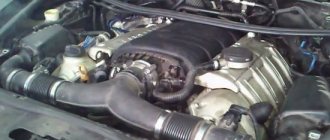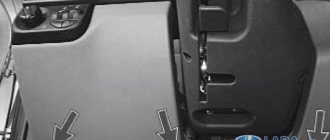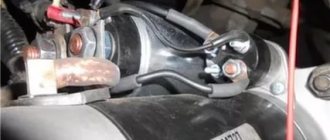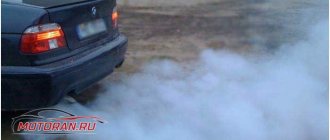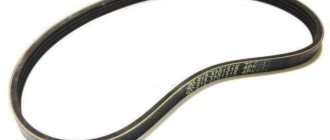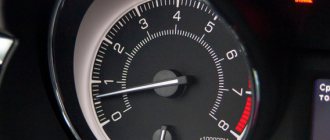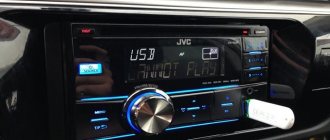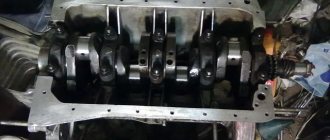The engine starts and stalls: troubleshooting
So, if a similar problem appears, then it is necessary to take into account a number of features. First of all, the operation of the internal combustion engine after startup will be influenced by the following factors:
- fuel supply;
- air supply;
- spark on spark plugs (for gasoline internal combustion engines);
- correct operation of glow plugs (for diesel engines);
- proper operation of the ECM and electronic sensors;
In this case, malfunctions
CPG
, low compression, significantly out of phase
timing belt
and other nuances in this case are taken into account, but do not come to the fore. The fact is that if there are serious problems, the power unit will most likely not start even for a short time.
With that said, you should first start by checking the main possible causes:
- Quite often, malfunctions in the operation of the alarm system and the anti-theft system can cause the engine to fail to operate after starting. In other words, the immobilizer does not turn off and continues to block the start of the internal combustion engine, which is its main function to prevent vehicle theft. If the alarm blocks the engine, then you need to check the operation of all elements, try to reset the error, turn off the anti-theft system, etc.
- Problems with the IAC and idle air valve often arise due to contamination of these elements. You should also pay attention to the cleanliness of the throttle valve. As for the crankshaft sensor, incorrect data that it transmits to the ECU can cause the engine to stall immediately after starting.
- Poor quality fuels and lubricants can also cause problems. As a rule, problems begin in cases where low-grade fuel was filled or the engine uses motor oil that does not meet the recommendations/has lost its properties.
- A faulty fuel pump, air leaks in the fuel line, the formation of air pockets and dirty fuel filters do not allow creating the required pressure in the power system or supplying fuel in the required volume.
- The air filter and its contamination leads to the fact that the working mixture is significantly over-rich. In other words, the engine does not have enough air to burn fuel, and the spark plugs flood.
- Problems with ECM sensors (EGR sensor, oxygen sensor, DPKV, etc.) can lead to both unstable engine operation at idle and a complete engine stop after starting.
We also recommend reading the article about
why does the engine stall when braking?
. From this article you will learn about the reasons why the power unit begins to operate unstably or the engine stalls after pressing the brake.
Now let's look at the most common problems and how to fix them, looking at them in detail.
- First of all, the culprit may be the low level of fuel in the gas tank and its quality. If gasoline or diesel fuel runs out, then the engine will start using the remainder in the power system, but further operation will be impossible.
As for quality, unscrupulous sellers can use both various additives and ordinary water to dilute fuel. To check this, part of the fuel is poured into a transparent container, after which it is necessary to allow the liquid to settle.
Water is heavier than gasoline and settles to the bottom. If this is the case, then the problem has been identified. To solve this, it will often be enough to dilute the existing fuel with high-quality fuel, after which the engine can usually be started.
However, this doesn't always work. It is possible that the supply of low-quality fuel in the tank will need to be completely drained, after which the power system will be thoroughly cleaned and flushed.
If the malfunction occurs on a diesel engine, then problems with fuel can lead to more serious consequences. For example, if a diesel engine starts and stalls in winter, then the cause may be waxed and frozen diesel fuel. In this case, diesel fuel needs to be heated, filters cleaned, etc.
It is much worse if gasoline accidentally gets into the tank of a diesel car. In such a situation, there is a high risk of serious damage and failure of expensive diesel engine fuel equipment (fuel pump, injectors).
- The next reason why the engine starts, runs and stalls may be the battery. The fact is that many systems and actuators require sufficient battery charge for normal operation.
We are talking about the fuel pump and ignition system, which consume electricity from the battery not only at the time of start-up, but also after the engine has started running. As a rule, if a working starter has difficulty turning the engine, then this indicates a severe discharge of the battery.
- Another element that is worth paying attention to in the event of a sudden stop of the internal combustion engine after starting is the fuel pump. On modern fuel-injected cars, the fuel pump is located in the fuel tank.
In order to check its operation, you need to turn the key in the lock, turn on the ignition and listen carefully. In the first seconds after turning the key, a characteristic light hum/buzz should be heard. This sound lasts for several seconds, indicating that the fuel pump has started working and is building pressure in the fuel system.
If such a sound is not heard, then it is necessary to determine the reason why the gas pump does not pump gasoline. The pump motor itself, the fuel pump relay, fuses and other electrical circuit elements may fail. Let's also add that the ECU can turn off power to the pump if the crankshaft sensor does not send a signal.
It is also important to consider that the filter mesh on the fuel pump may become clogged. For accurate diagnostics, it is advisable to measure the fuel pressure in the fuel rail using a pressure gauge.
Another common cause may be the fuel filter. If it is contaminated, then a decrease in throughput leads to the fact that the pump cannot pump gasoline in the required volume for normal engine operation. As a result, the unit stalls after starting.
- If there is fuel in the system and the pressure is normal, then the problem may be related to the ignition system. Most often, spark plugs and spark plug high-voltage wires fail. A typical symptom for wires is that the engine stalls after washing or in wet weather.
One way or another, you need to unscrew the spark plugs, clean the elements, and check them for a spark. If the spark plugs have not been changed for a long time, then it is better to immediately install a new set. As for armored wires, they also need to be checked for functionality and replaced if necessary. At the same time, on some cars you need to check the ignition timing.
- The synchronous operation of the valve mechanism may be disrupted due to the fact that the timing belt or chain may be incorrectly installed, stretched, worn out and may jump on the pulleys. As a result, the opening and closing of the intake and exhaust valves does not correspond to the engine strokes.
In this case, to eliminate the problem, you need to check the indicated elements, align the timing belt to the marks and perform other necessary procedures.
- ECU malfunctions are less common, but this possibility should not be ruled out. Cases where the controller was reflashed, chip tuning was performed, or LPG was installed on the car deserve additional attention.
Regarding the various sensors, attention should also be paid
Mass air flow sensor
And
TPDZ
, as well as the oxygen sensor in the exhaust system (lambda probe). If on the dashboard
"check" is on
during a short-term start of the internal combustion engine or no signs of problems are visible, it is still necessary to perform
computer engine diagnostics
.
You can do this diagnosis yourself. To do this, you will need an adapter for the OBD2 diagnostic connector, which will allow you to read error codes and display the received information on the screen of a tablet, laptop or smartphone.
Ignition and spark plugs
An incorrectly set ignition timing can cause the engine to stall, including stalling immediately after starting. But ignition is a problem that manifests itself in any mode of engine operation. The engine will shoot, sneeze, malfunction and trip, in general, it will not work stably. Therefore, problems with the ignition system most likely will not be able to take you by surprise.
By refusing to work immediately after starting, the car may subtly hint to you that it is time to replace the spark plugs. True, in this case, failures and other violations will appear in other operating modes.
Due to a clogged injector, the car can also start and immediately stall. It is better to clean the injector by dismantling it and mechanically cleaning it. The fact is that the chemistry used for such purposes can dissolve the dirt and soot that clogged the injector, but does not remove them. And even the designer of this engine will not tell you where this very dirt will end up.
In rare cases, a completely clogged air filter can cause similar symptoms. But this is rather an exception, and checking it is not so difficult. Just run the engine for a minute without the air filter.
The required amount of fuel is not supplied
The photo shows the fuel pump.
Most likely, the problem lies in the pump, which in the vast majority of cars is located in the fuel tank. This pump either fails or its fine mesh becomes clogged.
- Read about replacing the fuel pump
There may be a lot of debris and water in the fuel tank. The mesh catches and delays all this, acting as a filter. In the warm season, all this debris does not interfere with the normal circulation of fuel; it easily enters the combustion chamber. But in winter there is a different picture. In cold weather, water and debris freeze to the mesh rods, and fuel can no longer pass through the mesh at the required speed. And if you manage to pump a little more to start the engine, then you can’t get it to work! Actually, for this reason the engine stalls. Cleaning the mesh is not difficult - the main thing here is to get to the fuel pump.
What to do first
You should start, oddly enough, by checking the presence of fuel in the gas tank, and you should also make sure that the anti-theft system is turned off. It is possible that you were mistaken for a car thief. These are the simplest solutions to the problem, but unfortunately, they are also the rarest.
Next, if the car continues to stall immediately after you start it, check to see if the fuel tank pump is working. To do this, put someone behind the wheel, open the tank cap, and ask an assistant to turn on the ignition without starting the engine. In the first seconds after turning on the ignition, you should hear the pump running. If you don't hear it, the pump may be faulty. It’s also worth checking the fuel filter, especially if you haven’t changed it in a while.
In addition, an air bubble in the fuel system may cause the engine to spontaneously stop immediately after starting. And solving this problem is much more difficult. Often you have to push the car or tow it in order for the engine to start. But all this is possible only for cars with a manual transmission.
1. Malfunction of the anti-theft system.
Failure may occur as a result of:
- attempts to start the engine with the key of another car;
- alarm activation;
- failure of the key chip;
- extremely low battery charge.
A malfunction of the immobilizer system is often reflected on the device screen in the form of a key. Some devices notify you of a problem with a yellow LED signal or the inscription 'IMMO'. Trying to configure the device yourself can make the situation even worse, so it is better to contact a specialist who has the appropriate equipment. Such repairs will cost a small price.
Don't panic
When the engine starts and immediately stalls, many drivers begin to panic a little, because not every driver can immediately identify this malfunction. Pulling on wires, pipes, kicking the car wheel out of helplessness, as a rule, does not produce results.
Usually the car will start after a while, and then the situation may repeat itself.
I would like to note that the reason when the engine starts and immediately stalls can be various malfunctions specific to a particular car model, ranging from a malfunction of the VVT-i valve, or more precisely due to its clogging, and ending with burning of the fuel pump relay contacts which often happens on Honda cars.
It is worth noting that recommendations are given here not for complete dummies, but for those who can already independently perform simple work to identify the malfunction and eliminate it.
For people who do not understand anything about these issues, it is better to immediately go to a car service center, and if the engine starts and immediately stalls, and this is repeated several times without success, call a tow truck.
Old cars without newfangled computers - why does the engine stall?
If you are faced with a problem such as a constantly stalling engine in an older car that does not have new computerized control systems, the problem will be much easier to solve. It is enough to determine whether there is a shortage of air or fuel. If the car starts, runs for a few tens of seconds, and then stalls, the problem may be in the air.
If the engine does not have enough fuel, it will be started only once, and then you will have to wait a long time until the filters collect enough gasoline to operate the power unit. Problems in gasoline supply pipes occur regularly, and the permeability of lines and system pipes deteriorates. Also, the air system does not always work perfectly. The main reasons for such problems are as follows:
- the fuel line is clogged, gasoline flows too slowly, the engine does not have enough fuel to operate;
- the fuel supply pipe to the power unit is bent, its flow capacity has decreased;
- the power unit began to consume significantly more gasoline than supplied by the standard supply system;
- the air filter is clogged, the required amount of air does not flow into the engine;
- the turbine, which is partially responsible for the air flow into the power unit system, has broken down;
- The carburetor jets or injector nozzles are clogged, which leads to insufficient fuel flow into the engine.
There can be a number of such problems, but they all have one common picture - fuel or air does not enter the engine in sufficient quantities. In this case, a rather interesting feature occurs. Gasoline is collected in the engine tanks for a certain operating time, then it is produced in a few tens of seconds, and the engine simply stalls.
These problems can explain most of the problems that occur in the fuel systems of older powertrains. These problems are also typical for new engine systems. Only diagnostic equipment can often demonstrate this problem to the driver by displaying a specific engine error code on the on-board computer screen. Often, due to such a problem, the “Check Engine” lights up on modern cars.
Symptoms under a microscope
How do motorists usually describe a malfunction? Long story short, the car started and immediately stalled. If deployed, the engine started and immediately stopped after a couple of seconds. Observations are sometimes supported by numbers. For example, the speed at start drops to 500 rpm and the car stalls.
Sometimes the problem can be resolved by pressing the gas immediately after starting the engine. In some cases this helps. And sometimes it’s useless, the engine still doesn’t hold speed. But it’s worth trying to press the accelerator pedal immediately after starting in any case. It is quite possible that this action will help you get to the nearest repair site on your own.
depressurization of VUT, malfunction of the fuel pump, fuel filter
A situation in which the car stalls immediately when you press the brake can occur at any time and does not depend on the type of engine. There are many reasons leading to a malfunction. This situation not only causes discomfort during the trip, but can also provoke a dangerous accident.
Most often, the problem lies in one or another malfunction of the brake system. In order to accurately find out the cause of the malfunction and eliminate it as soon as possible, it is worthwhile to fully diagnose the car and stop driving it for a while.
Main reasons
There are quite a few reasons why a car stalls even when braking smoothly. Most often these are the following malfunctions:
- if the car has an injection engine, then problems often arise in the operation of the idle speed sensor;
- breakdown of the VUT or depressurization of its hose;
- incorrect functioning of the fuel pump;
- malfunctions in the car's electronic control unit.
Depressurization of VUT or its hose
If the car starts to stall when braking, then the first thing you need to do is check the brake system, namely the vacuum booster and hose. It's quite easy to do this:
- Amplifier. Its weak point is the membrane, it is located between the brake pedal and the master cylinder. Due to the violation of its integrity during braking, a large amount of air accumulates in the brake fluid, so the engine stops. Checking the serviceability of the membrane is very simple. After the engine has been running for some time, you need to press the brake pedal and turn it off. The pedal is held down for 30 seconds. If the pedal offers no resistance and does not rise, then everything is fine. Otherwise, you will have to go to a car repair shop to replace the amplifier with a new one, since this unit is not repairable.
- Hose. Its depressurization due to damage leads to a lean air-fuel mixture, which causes the engine to quickly stall. Finding out that a part is faulty is quite easy. It is necessary to conduct a visual inspection for existing damage. Additionally, it is worth disconnecting the vacuum booster and the hose. The free end is clamped with your fingers and the engine is started. When the hose is sealed, the engine speed will immediately increase, otherwise there will be no visible changes in operation.
If the reason for the engine stopping is problems with the VUT, then it is important to eliminate them as soon as possible, and until then not to use the car, as the risk of getting into an accident increases many times over
The reason is the fuel pump and fuel filter.
The situation is a little more complicated if the fuel pump is damaged. Its proper operation can be checked using a monometer; it determines the pressure level in the fuel line. In other cases, you can disconnect the fuel outlet hose from the pump and try to bleed it. If it is working properly, fuel will come out of the hole. If this does not happen, then the part is dismantled and sent for diagnostics. Depending on the complexity of the damage, it can be repaired or replaced with a new one.
Idle speed sensor malfunction
This device allows the engine to maintain a certain number of engine speeds when the driver stops pressing the gas pedal. If there is a malfunction in the sensor, then floating idle speed becomes clearly visible.
It is not difficult to identify a malfunction: the control circuit of the sensor is called with a tester, after which a decision is made to repair or completely replace the part.
Other reasons
The malfunctions described above are not the only reasons why the car stalls when you press the brake. The following malfunctions often lead to this problem:
- spark plugs unsuitable for further use;
- problems arising in the on-board electrical network;
- exhausted injectors;
- throttle valve clogged.
To diagnose and fix these problems, you should contact a car repair shop, and this must be done as soon as possible. Malfunctions that occur in the braking system pose a serious threat to the lives of both the driver and passengers.
Fuel quality
It is quite easy to come across fairly low-quality and trivially diluted diesel fuel or gasoline at domestic gas stations. It causes the engine to stall because there is a lot of water in the fuel. The optimal solution would be to drain the liquid and fill the tank with a high-quality composition.
Other situations also occur with diesel engines when, during severe frosts, paraffins harden, causing fuel filters to become clogged, pressure in the fuel line drops, and the car stalls. It is recommended to check the condition of the glow plugs. If you wish, you can use special additives called antigels. When there is excess water, moisture removers sometimes help. But since these are additives, motorists have different attitudes towards them. They will definitely not force their use.
By the way, write in the comments how you feel about additives and how often you use them. It will be interesting to know your opinion on this matter.
Irregularities in fuel supply.
One of the most common reasons is insufficient fuel or its poor quality. For example, leaving a car with a low level of gasoline, over time, condensation that rolls to the bottom of the tank allows you to start the engine, but not for long. In addition, cases of sale of fuel diluted with a special composition (for example, gasoline or plain water), including at gas stations, have become more frequent.
The specific composition of diesel fuel can affect the starting of a car in the winter season. The paraffin contained in it becomes hard on frosty days, which prevents it from passing through the filter. As a result, the fuel line suffers from low pressure. For such cases, special anti-gels have been developed, which should be in the arsenal of the owner of a diesel car.
2. Incorrect operation of the exhaust system
The photo shows mounting foam in the exhaust pipe.
You can conduct a simple experiment: cover the exhaust pipe with a rag and start the engine. After about ten seconds it will stall, and if you remove the rag and start it again, it will stall again. This happens because the gases resulting from combustion are not exhausted through the exhaust system, but are mixed with the air entering the engine. If there is insufficient air mixture, the engine simply cannot burn fuel normally and stalls.
In the photo there is ice in the exhaust pipe
There can be two reasons for this phenomenon: clogging of the muffler itself or water getting into it. It happens that the water freezes. Of course, this rarely happens, but this possibility should not be completely ruled out. Also, some “prankster” may stick a plastic bag or stone into the exhaust pipe. In a situation where the engine cylinder head gasket is worn out, when antifreeze disappears, water may enter the muffler.
The first step is to get rid of the water in the muffler, and then look for the cause of its appearance.
Diagnostics
You can identify the specific reason why the engine stalls after a cold start by checking all components. Non-working elements are changed or repaired if they are repairable.
Advice! On vehicles equipped with an on-board computer, computer diagnostics will be required using a scanner with OBD-II protocol.
OBD 2 connector
If there is no device, the car is taken to a service station. The master diagnostician will connect the scanner, count the errors, and develop a recovery plan based on them. In cars where there is no on-board computer, they are diagnosed by searching through all the components, which takes a lot of time.
Active alarm
I can’t say that the situation is very common, but sometimes it occurs. Plus, it is easy to deal with, since we are not talking about malfunctions of the engine or other systems.
Some cars have an alarm that blocks not only the door locks or steering wheel, but also the engine. The system works in such a way that after an unauthorized start it literally stalls immediately. This is a fairly effective protection that does not allow you to drive far in a stolen vehicle. Check to see if your car has this safety feature disabled and try starting again.
Such security systems can currently be installed on any car, be it:
see also
- VAZ 2110;
- VAZ 2114 injector 8 valves;
- Volkswagen Passat B4;
- Mercedes E class;
- Lada Kalina;
- VAZ 2107;
- Renault Megane;
- Ford Kuga;
- Mazda 6;
- Audi A5;
- Honda Civic, etc.
How justified the costs of installing such an alarm will be, everyone decides for themselves.
Air supply problems.
Possible reasons include:
- the presence of a large amount of contaminants on the air filter;
- broken fuel pump;
- excess dust in the fuel filter.
Thus, a dirty air filter prevents the engine from receiving air. As a result of a lack of oxygen, the spark plugs turn black, excessive fuel consumption occurs, which ultimately leads to the impossibility of starting the engine. Failure of the fuel pump and dust on the fuel filter lead to disruptions in the power supply system and fuel supply.
3.1. Lack of vacuum in a car with a carburetor
In the absence of vacuum both in the carburetor and in the vacuum hoses with the intake manifold, an air-fuel mixture that disrupts engine operation is formed. Only checking the vacuum lines can help identify depressurization. Perhaps in this way any damage to pipes or hoses will be detected, replacing which will eliminate the problem.
3.2. Air damper malfunctions
The function of the damper in a carburetor car is to regulate the flow of air, creating the necessary mixture in the combustion chamber. The following can lead to the formation of a poor-quality mixture in the engine:
- breakdown of the mechanism that returns the damper to its seat;
- damage to the drive cable;
- excess dirt on the damper, preventing it from returning tightly to its original position.
Any of the reasons leads to the stop of the motor.
Other reasons
If almost everyone can cope with the reasons listed above, then with the following, many will have to seek help from specialists, read additional literature and become more familiar with the operating manual of your vehicle.
No less likely reasons that the engine starts up at first, but then stalls after a short time, can be:
- insufficiently strong fuel pressure created;
- breakdown in the fuel vapor recovery system;
- idle speed too low;
- malfunction of the air damper;
- breakdown or malfunction of the throttle position sensor;
- problems with the mass air flow sensor;
- malfunction of the exhaust system equipped with a catalyst;
- oxygen sensor failure;
- problems with spark plugs;
- breakdown in the ignition coil;
- incorrectly set valve clearances;
- crankshaft sensor malfunction;
- breakdown or clogging of the USR valves;
- problems with the gas distribution mechanism;
- malfunctions in the electronic control unit.
You can clearly see that there are more than enough reasons and potential problems. It is unknown which one you will face. But you need to be prepared for anything.
Proper operation of the vehicle, timely diagnostics and maintenance can minimize the likelihood of sudden problems. But even such measures will not protect you 100%. Therefore, I recommend that you at least study the list of potential reasons why the engine may start, but then still stall after some time.
Finally, I would like to ask. Has it ever happened to you that you forgot to refuel or did not calculate the amount of fuel remaining in the tank, which is why you stalled in the middle of the road?
Thanks to everyone who reads us! Subscribe, leave comments, ask questions and tell your friends about us!
4. Irregularities in the ignition system
Quite often, spark plugs or glow plugs, as well as high-voltage wires, need to be replaced. The car may stall immediately after turning the key as a result of:
- lack of distributor connection contact;
- damage to the ignition coil;
- breakdown of high-voltage wires.
Stopping the engine during rain or after visiting a car wash often indicates problems in the wires. And the loss of connection contact is often preceded by car repairs or replacement of any system. In any case, it is recommended to check the integrity and cleanliness of the spark plugs and their ability to conduct a spark. If the spark plugs were changed more than 30 thousand km ago, they should be replaced with new ones.
Injector malfunction
The next reason that the engine starts and immediately stalls is a malfunction of the injector. Since most modern cars have a forced fuel injection system, this malfunction is very common.
Don't make mistakes.
What should not be allowed when operating fuel-injected cars:
- Do not disconnect the battery while the engine is running.
- Try to play with lighting as little as possible, and in general, handle food as carefully as possible. Injection cars are very sensitive to such manipulations.
- Try not to disconnect the ground on the car. Although I turn off the mains in my car in winter if I don’t drive for a long time, and so far I have not noticed any discomfort in operation, although many experts say that it is possible to erase information in the computer. I just try to let the car idle for up to 3 minutes when starting the engine.
- Injector-injected cars are not very fond of charging and starting devices, since when they are used, the voltage jumps significantly and the ECU can burn out.
ECU board.
- If a neutralizer is provided in the design of the car, then try not to start the car by towing or pushing it down a hill, as unburned fuel is formed, which, if it gets into the neutralizer, can ignite spontaneously.
- Do not allow water to enter the injector; this is strictly contraindicated. To do this, change fuel filters in a timely manner and fill with high-quality gasoline.
What does a neutralizer look like?
- If your car is equipped with an L probe and a neutralizer, then think about whether you should take the risk by using leaded gasoline. When using such gasoline, the L-probe, in addition to the fact that it itself can quickly break down, it will transmit incorrect data to the ECU, indicating a large amount of oxygen, and this, to put it mildly, is not very good, as it can lead to local overheating of the engine .
So, we return again to our problem, the engine starts and immediately stalls or does not start at all.
How to determine why an injection engine stalls after starting
Before you begin to determine the cause of the malfunction, you should definitely check the fuel level in the tank. Please note that gasoline vapor is enough to “seize” the engine, but if there are problems with its supply, then the small consumption required to operate at idle speed is not enough.
In gasoline engines with an injection system, when troubleshooting, the following is checked step by step:
- fuel and air supply;
- operation of the ignition system;
- operability of sensors and ECU
- compression in the cylinders.
If this does not bring the required result, then remove the protective cover of the timing drive (valve mechanism cover for an internal combustion engine with a chain drive) and check how accurately the opening and closing moments of the valves coincide with the operating strokes of the internal combustion engine.
Video: Renault Logan starts and stalls. There is a solution!
Problems with the fuel supply system
At the first stage, the functionality of the fuel pump is checked. To hear that it is functioning, turn on the ignition - a low buzzing indicates that the unit is pumping gasoline into the fuel line. If the fuel pump is silent when power is applied, then check whether the on-board network voltage is supplied to it.
The absence of 12 V on the connector is a sufficient reason to check the integrity of the wiring, relays and contacts. If the unit is operating normally, the reason for the engine stopping may be insufficient pressure in the fuel rail. During start-up it is at least 3 atm, and when idling – 2.5 atm. The reason for low readings can be either a clogged fine filter or fuel pump mesh, or its low performance. If the pressure drops sharply (below 0.7 atm) immediately after turning off the fuel supply, then this is evidence of a leak in the line or improper operation of the pressure regulator. In the first case, we check and eliminate the cause of gasoline leakage, and in the second, we remove it from the chain or turn off (temporarily) the control device.
This is interesting: What you need to know:
Throttle contamination
Although experts claim that injection engines work even when the air filter and throttle are clogged, it cannot be ruled out that the engine stalls when cold due to breakdown of the throttle valve drive parts. Remaining in the closed position, it simply stops the air supply. In addition, a decrease in engine speed to critically low values occurs due to the idle speed regulator clogged with carbon deposits. To get rid of the problem, the elements of the throttle device are cleaned using a carb cleaner and blown with compressed air.
Ignition problems
Normal pressure in front of the fuel rail and the absence of problems in the air supply system suggest that the fuel mixture enters the cylinders in full, but does not ignite due to sparking problems. Drivers blame spark plugs for this, but, as practice shows, the car often starts and stalls after a few seconds due to problems with high-voltage wires and tips.
The test begins with the candles. To do this, they are unscrewed, cleaned and checked for a spark. The latter is performed both with the help of a special device and on the engine - for this, an armored wire is attached to the spark plug and the crankshaft is turned with a starter. Since in the latter case there is a risk of damage to the ECU output circuits, ensure reliable contact between the spark plug skirt and the vehicle ground.
Sparking problems due to wires and spark plug tips are due to damage to the internal conductors or failure of the external insulation. It is easy to check the integrity of the conductors with a tester, but only a megger will show breakdown and current leakage. If you don’t have such a device in your arsenal, then use a simpler method. To do this, wait until it is dark and ask an assistant to start the engine. Damage to the high-voltage part of the ignition system can be judged by high-voltage discharges on the surface of the coils, conductors and tips.
Sensor and ECU malfunctions
Electronic engine control systems (ECMs) control the operation of the fuel pump, injectors and spark plugs based on data received from numerous sensors. It is not surprising that if some of them are damaged, the engine does not start, runs intermittently, or stalls literally immediately after starting.
Problems in the ECU wiring circuits are indicated by the “Chek Engine” indicator on the dashboard. To localize and troubleshoot a fault, you need to either close certain contacts in the ECM diagnostic block and read the error code, or connect a scanner operating using the OBD-II protocol to the connector.
Violation of synchronous operation of the valve mechanism
If these methods do not bring a positive result, then check whether the phases of the gas distribution mechanism are out of order. A similar problem can occur due to excessive stretching of the timing belt (chain) or its displacement by several teeth. To fix the problem, you need to mark the crankshaft and camshaft and tighten or replace the belt.
Something else useful for you:
- The car does not start well when cold (injector, diesel, carburetor)
- Adjusting the idle speed of Ozone and Solex carburetors
- The main causes and signs of unstable engine operation at idle
How to fix the problem
When the fault has been identified, you should try to repair the unit. This is suitable for the fuel pump, engine valves, and other parts that are either impossible to repair or too expensive to buy.
It is better to contact professional mechanics for both diagnosis and repair. This will save time and also eliminate the worst consequences that will appear due to makeshift repairs carried out in person.
A running engine may stop working for several reasons, including problems with the ignition, fuel system, exhaust and other components. For an accurate diagnosis and professional repair, you need to turn to professionals, because otherwise the situation can only worsen.
Air filter
See also
If it becomes clogged, the intake manifold will begin to receive insufficient oxygen. This leads to so-called oxygen starvation.
A lack of air provokes the creation of a mixture too rich in fuel. As a result, the spark plugs will flood, they will begin to turn black, and fuel consumption will increase. But usually the engine still does not stall. It can turn off on the go in the most critical situation, when there is really practically no oxygen. Sometimes the engine cannot start at all, or turns off a few seconds after starting. There is nothing difficult in eliminating such a malfunction. Even a beginner can handle it.
You will need to find the air filter, check its condition, clean it or replace it. On many machines, the air ducts and filter housing also need to be cleaned.
Complete sabotage
The most deplorable situation, the engine does not start at all.
First of all, you need to maintain composure and not scold the car itself. Only after this, we calmly begin to find out the reason why the engine does not start.
Do not allow the battery to be severely discharged by pointlessly rotating the engine crankshaft, the energy will still be useful to you, but where you will charge the battery if you are far from home is the question. Although for the electronic unit itself 8 Volts will be quite enough. But, of course, they won’t be enough for the starter.
When you have calmed down, be sure to check:
- How does the fuel pump work and is there any fuel in the tank?
- Is there ignition?
- Is the engine crankshaft timing sensor functioning?
- Have the injectors failed, although the failure of several injectors at once is too much, this happens very rarely.
- The ECU is working. But this device also fails very rarely.
Finding out the cause of the problem
Now let's figure out how to quickly find out:
- The performance of the fuel pump, of course, is determined by its sound. If there is no sound, then check the wiring and provide 12 V supply to it. Pay attention to the pressure in the fuel system, it should be within 2 - 3 bar while the pump is running. If the fuel supply is stopped, the pressure in the system does not drop immediately. If the pressure drops sharply and there are no fuel leaks, then pay attention to the fuel pressure regulator. At least it can be silenced for a short time.
- Checking the ignition. To avoid burning the ECU, the spark plug must be connected to ground as best as possible.
- When checking the synchronization sensor, first of all, we pay attention to the integrity of the wiring and its shielding.
- As for the ECU, you need to try to move all possible connections. There is a high probability that something has come loose somewhere.
- Notice if the Check Engine light is on. If it lights up, then all is not lost and the ECU is still working. You need to know that it is not yet possible on VAZ cars without a tester to find out the error code and identify the location of the fault.
- If a suspiciously large number of error codes are displayed, then you need to pay attention not to the sensors, but to the fact that some part of your car has completely disappeared.
- You should also pay attention to the performance of the crankshaft synchronization sensor and the performance of the injector control system. But all this requires a special tester, and rarely does anyone carry this device with them in their car. Yes, and it is advisable for specialists to perform such work.
- But many people can check the voltage in the network. As a rule, when the engine is running it should be 14 V, when starting the engine 8 V, and when the engine is not running 12.5 V.
- Be sure to check the integrity of the camshaft drive belt and pulley. It's not hard to do.
- And the last hope. We disconnect everything possible from the ECU (electronic control unit), only leaving the crankshaft synchronization sensor. But again, if you know what you're doing. If you don't know, it's better not to interfere.
The engine still starts, but it is problematic:
- Check the air filter for clogging. If you have completely forgotten where it is, then everything is clear. Go ahead, buy a new filter, or at least clean the old one.
- Check the fuel pump as described above.
- When starting the engine, depress the clutch, this will make starting easier.
- Pay attention to what temperature the coolant sensor shows and what it actually is. Deviations should be within 5, 6 degrees.
- Again, check the car's voltage. What voltage should be, see above, paragraph 8.
- Pay attention to the quality of the fuel. Ask yourself the question, “Where did I refuel today?”
- We move all possible connectors. It’s corny, but sometimes it helps.
- We look at the camshaft drive belt.
Also read why the car engine does not pull.
These are the simplest actions that are available to many drivers. To conduct a more detailed diagnosis of the cause of poor engine starting, of course, it is better to contact a car service center. Professional equipment and devices will already be used there.
If the car does not start, read about other reasons here.
Generator problem
The most important reason why the engine stops working under certain loads is a poorly working or not working at all voltage generator.
At
starting the engine
Energy is taken from the battery, and if the battery has sufficient charge, then the malfunction will not be immediately noticeable. But after working a little, the battery will begin to discharge, since the proper level of energy is not supplied to it. As a result, the engine stops due to a small amount of energy. If the battery was initially weakly charged, it may happen that the injector starts and stalls.
Why is the air/fuel mixture incorrect?
If the car stalls immediately after starting the engine due to problems with the air-fuel mixture, you should check the throttle valve and fuel pump.
Throttle valve
Most often, the reason that a “poor” or “rich” air mixture enters the engine cylinders lies in a malfunction of the throttle valve. If the element is heavily soiled, problems may arise with its opening or closing. Accordingly, if the damper does not close completely, excess air will enter the cylinder, and when it cannot open due to contamination, on the contrary, there will not be enough air.
During operation, combustion products with oil particles settle on the throttle valve. If it is heavily contaminated, it ceases to perform its intended functions. To get rid of the problem, you need to properly clean the throttle valve, as well as the junction with the intake manifold, where it is recommended to install a new gasket.
Fuel pump
Since the quality of the fuel leaves much to be desired, the fuel pump is equipped with a filtration system for the gasoline supplied to the cylinders. A small fine mesh traps dirt that is present in the fuel coming from the tank. If the “honeycombs” of the grid are completely clogged, then a sufficient amount of gasoline simply will not be able to flow through the fuel pump, which will lead to the engine turning off immediately after start.
Please note: This problem is relevant in winter. During the cold season, the fuel in the tank is more viscous, as is the dirt. If in the summer it is washed out by a new stream of liquid gasoline, then in the winter the debris freezes on the fine mesh, preventing the fuel from passing through.
To fix the problem, you need to clean the filter of the dirty fuel pump. To do this, you will need to remove it from the car and remove the dirt. If the problem with contamination of the fuel pump is observed regularly, it is necessary to clean the gas tank of debris accumulated in it.
6. Violation of the thermal clearance in the valves
It should be noted that it is recommended to inspect clearances on Russian cars at least once every 30 thousand kilometers. For comparison: owners of a foreign car only need to evaluate the condition of the gap once every 70 thousand. Why can a thermal gap affect the entire operation of the engine? The fact is that an unbalanced gap position leads to gradual tapping of the valves. This leads to a decrease in the life of the valve system and noisy engine operation. Failure to take action in a timely manner ultimately results in the vehicle being unable to start.
Thus, there are a great many reasons for the engine stopping after turning the ignition key. However, most of them are one way or another the result of failures in the fuel configuration, ignition system or electronic control. The operation of the motor may stop even as a result of severe wear. This will be indicated by worn cylinder walls and rings.
Source of the article with more detailed information and tables:
https://kak-pochemy.ru/pochemu-mashina-zavoditsya-i-glohnet/
Features of troubleshooting in diesel engines
It would seem that the absence of an ignition system in a diesel engine should sharply narrow the range of reasons why the engine stops immediately after starting. And, nevertheless, due to the more complex and sensitive diesel power system, searching for a “weak spot” when problems arise with a sudden engine stop does not become one iota easier. Reasons for the malfunction of diesel engines:
- problems associated with glow plugs;
- malfunctions of fuel equipment;
- insufficient compression in the cylinders;
- violations in the exhaust gas recirculation system.
When starting to search for the reasons for the unstable operation of a diesel engine, we first check whether fuel is supplied to the injectors. To do this, loosen the nut on one of the supply lines and turn the crankshaft several times with the starter - the fuel pump creates such pressure that fuel begins to leak at the slightest depressurization. If this does not happen, then look for the reason in airing of the fuel supply system, a clogged filter element, incorrect operation of the regulator or a breakdown of the booster pump.
In winter, a sudden stop of the diesel engine can be caused by too thick diesel fuel and faulty glow plugs. When checking them, one should not exclude failure of the heater control unit or breakdown of the power relay. After turning on the ignition, be sure to check the voltage on each spark plug.
When diagnosing the fuel supply system, you should carefully inspect the exhaust. If a diesel engine smokes and stalls, the cause is clogged or faulty injectors. In the language of auto mechanics, they begin to “pour”, partially spraying the fuel. In other cases (for example, in Common Rail engines), the spray needle may “hang”, which upsets the pressure balance in the rail and the control sensor may command the ECU to turn off the engine.
It is impossible to carry out normal diagnostics of injectors at home - this will require a special stand. The help of specialists will also be needed in the case where the cause of the malfunction is a breakdown of the fuel pump - despite all its reliability, such a possibility cannot be ruled out.
But everyone can check the tension of the injection pump drive belt and the compression in the cylinders. Diagnostics of the cylinder-piston group is easy to carry out using the “folk” method. To do this, before starting, add 2-3 ml of engine oil to each cylinder - if the engine starts normally and runs for a few seconds, this indicates insufficient compression due to wear or damage to parts.
As in the case with a gasoline engine discussed above, we check that the marks match. The peculiarity of a diesel engine is that both the position of the camshaft and crankshaft, and the installation angle of the injection pump pulley are controlled - the moment of ignition of the fuel mixture in the cylinder at the end of the compression stroke depends on this.
Finally, we’ll tell you about another common reason due to which there can be no question of any stable operation of the engine - the EGR valve in the exhaust gas recirculation system. If it jams open, then an excess amount of combustion products enters the intake manifold and the engine stalls from lack of oxygen. Replacing the valve solves the problem - after that the diesel engine works as if nothing had happened.
Of course, we examined only those causes of unstable operation of power units that occur most often. The variety of modern engines and their design features often require an individual approach and special knowledge. If the fault cannot be resolved, do not be discouraged - perhaps it is not even a matter of experience and skills, but a simple lack of tools and diagnostic equipment. In this case, only service center specialists can help you.
Seal

